
Like many of the sights bordering Vienna’s Ring boulevard, the Austrian parliament building (German: Parlamentsgebäude) appeared in the second half of the 19th century.
- Built in the Hellenic style by Theophil von Hansen
- Reopened 2023 after major refurbishment
- Go inside this working parliament
- Large visitor centre with English displays
- Take an architectural tour (in English)
- Book a themed tour* of Vienna
- See also:
History and architecture
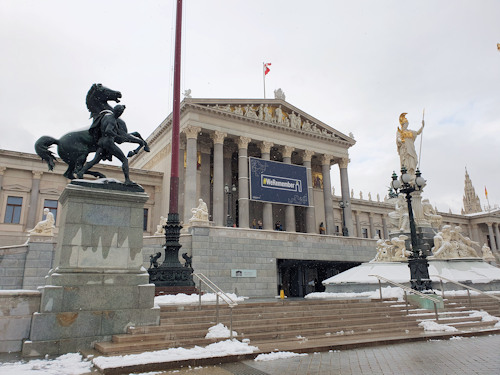
(Parliament in the snow)
The parliament building formed part of the urban renewal and expansion project that followed the decision to open up the Viennese defences to property development. The city walls went down; palatial townhouses and public buildings went up.
The architect was Theophil Hansen, and you’ll come across many other magnificent works by him on your travels across Vienna.
Hansen designed, for example, the Musikverein building (one of the world’s greatest concert halls), the former stock exchange, and the recently-renovated Academy of Fine Arts Vienna (home to the Gemäldegalerie public exhibitions).
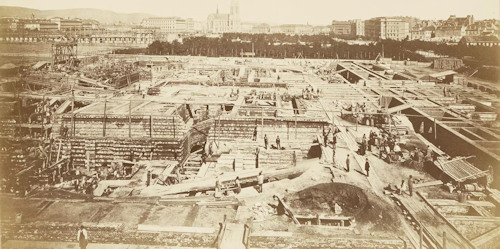
(Construction site of parliament in October, 1875, as captured by an anonymous photographer; Wien Museum Inv.-Nr. 93021/59; excerpt reproduced with permission under the terms of the CC0 licence)
Construction work on the Parlamentsgebäude began in 1874 and the building opened around ten years later, though some elements would only be finished after the turn of the century.
The building initially housed the Imperial council (Reichsrat) which included some elected representatives. Austria was still a monarchy at the time, so the value placed on democratic representation wasn’t quite what we understand it to be today.
Today, it houses Austria’s democratically-elected parliament.
Style and features
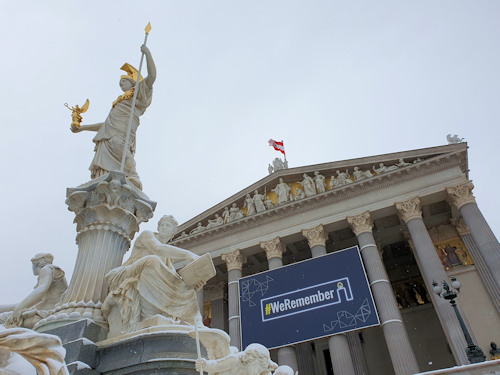
(Athena fountain)
Hansen deliberately chose a Greek style, to reflect the idea of law, freedom, and other relevant concepts popularized and/or developed by the Hellenic culture.
As such, classical motifs appear throughout the architecture.
For example, statues of Thucydides, Polybius, Xenophon, Herodotus (all Greek), Julius Caesar, Tacitus, Titus Livius and Sallust (all Roman) decorate the two large ramps at the front.
Xenophon has another Vienna connection: he wrote an early book on the art of riding, and his instructions eventually led to the art form practiced at the Spanish Riding School.
A white marble statue of Athena (the Greek Goddess of wisdom, war, and peace) tops the large fountain between the ramps. In her hand, she carries Nike (the Goddess of victory, not an early form of corporate sponsorship).
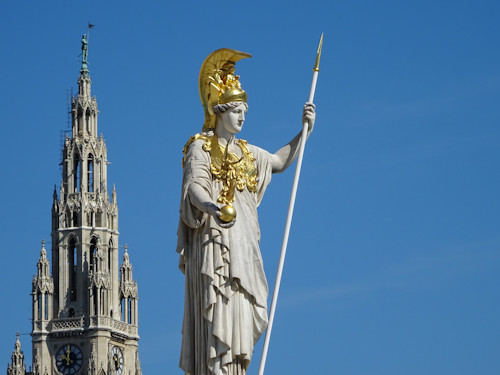
(Pre-renovation Athena with the tower of the Rathaus city hall in the distance)
Nike turns up elsewhere on the building too; she drives all the horse-drawn chariots that dominate the roof as symbols of victory.
Just under the topmost point of the front façade is a statue of Emperor Franz Joseph, in whose reign the building was constructed. He’s dressed appropriately in a toga and surrounded by human representations of the countries subject to his rule.
Other statues and reliefs dotted about the roof and elsewhere feature a mix of historical figures from Rome and Greece, representations of countries and other geographical features under the aegis of the monarchy, and representations of relevant human characteristics and activities.
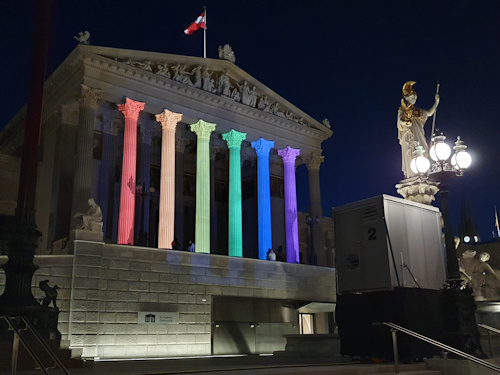
(Parliament in Pride colours)
They often use light effects or 3D installations to put the façade to good use in support of various causes. Examples include displays raising breast cancer awareness or highlighting the UN campaign against violence toward women.
If you’re wondering what it all looks like inside, take a peek for yourself (after registering online or at the entrance). The renovated building has a large visitor centre and you can even grab a coffee or meal at the in-house café and restaurant.
Needless to say, the Hellenic theme continues within. To see the magnificence of the various assembly rooms and other features, take one of the (free) English-language architectural tours.
How to get to parliament
You’ll probably stumble across the building on your travels anyway, especially if you walk around the Ring. Otherwise…
Subway: Take the U3 to Volkstheater or the U2 to Rathaus
Tram/bus: Take the D, 1, 2, 71, 46 or 49 tram lines (or the 48A bus) to Ring/Volkstheater
Address: Dr. Karl-Renner-Ring 1-3, 1010 Vienna | Website